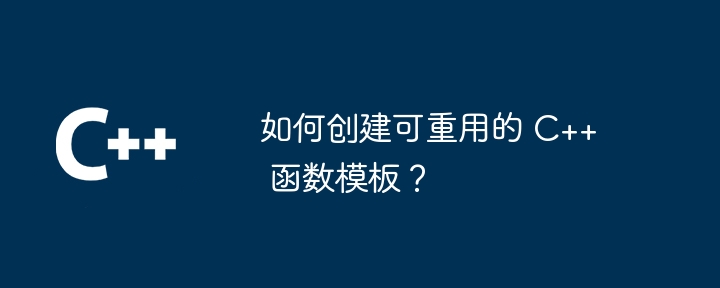
Function templates can be used to create functions that work on multiple data types by simply specifying the type used, saving time and reducing duplicate code. The specific steps are as follows: Use <class T> to specify the data type. Specify the return type. Name the function. Specify parameter list.

How to create reusable C function templates
Function templates enable you to create functions that can be used on many types of data. This saves time and reduces the amount of duplicate code.
Syntax
Function templates are declared using the following syntax:
template <class T>
returnType functionName(parameterList) {
// 函数体
}where:
<class T>Specify the data types to be used for the function's parameters and return value. returnTypeSpecifies the return value type of the function. functionNameSpecifies the name of the function. parameterListSpecifies the parameter list of the function. Practical case
Let us create a function template that finds the sum of array elements:
template <class T>
T sumArray(T arr[], int size) {
T sum = 0;
for (int i = 0; i < size; i++) {
sum += arr[i];
}
return sum;
}This function template can be used for any data Array of type T.
Using
To use a function template, simply specify the type you want to use. For example, to find the sum of an array of integers, you would do this:
int arr[] = {1, 2, 3, 4, 5};
int size = sizeof(arr) / sizeof(arr[0]);
int sum = sumArray<int>(arr, size);Similarly, to find the sum of an array of floats, you would do this:
float arr[] = {1.1, 2.2, 3.3, 4.4, 5.5};
int size = sizeof(arr) / sizeof(arr[0]);
float sum = sumArray<float>(arr, size);Advantages
Advantages of using function templates include:
The above is the detailed content of How to create reusable C++ function templates?. For more information, please follow other related articles on the PHP Chinese website!
 What are the differences between c++ and c language
What are the differences between c++ and c language
 Recommended learning order for c++ and python
Recommended learning order for c++ and python
 Cost-effectiveness analysis of learning python and c++
Cost-effectiveness analysis of learning python and c++
 Is c language the same as c++?
Is c language the same as c++?
 Which is better to learn first, c language or c++?
Which is better to learn first, c language or c++?
 The difference and connection between c language and c++
The difference and connection between c language and c++
 C++ software Chinese change tutorial
C++ software Chinese change tutorial
 Cost-effectiveness analysis of learning python, java and c++
Cost-effectiveness analysis of learning python, java and c++




